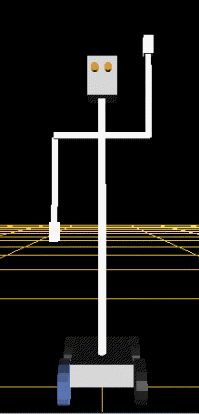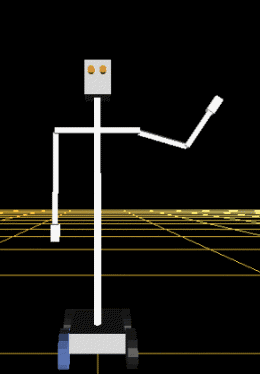Communicative power
This study investigated how avatars can be used for interpersonal communication, in particular in how people might use avatars for gesturing. I wanted to know how the appearance of an avatar affected a person's ability to invent gestures for the avatar, and to decode the meaning of an avatar gesture. I created two different avatars, one with an arm that moves only at the shoulder, and another that has both a shoulder and an elbow joint. I figured that the two jointed arm looks more realistic and therefore would have greater communicative power.

Avatar with one jointed arm.

Avatar with two jointed arm.
The user controls the avatar gestures using a graphical user interface. Dragging a mouse around a circle moves the avatar's arm. The quality of the avatar arm's movement is affected by simulated dynamics as well as by the movement of the user. This gives the avatar's arm a feeling of weight and momentum as if it were a physical object.
Study and Results
I described to participants a scenario in which avatars are used to represent people in a virtual meeting. As in some real meetings, only one person has the floor at a time. I suggested that avatar gesture might be useful as a means for the meeting attendees to signal feedback to the speaker, or to call for attention, much in the way that students raise their hands in the classroom to signal the teacher. The participants were asked to perform one of two different tasks. In the first task, the participant uses the avatar to invent gestures. In the second task, participants are asked to match avatar gestures to their meanings.
I found that the avatar design did not affect the avatar's communicative power. Participants were well able to invent gestures for both avatars, though they tended to favor one over the other. Those who preferred the simpler avatar felt it was easier to control. The two jointed avatar was favored by those who felt it looked more realistic. Simplicity and realism are just two of the many more factors that appeared to affect communicative power than mere arm jointedness. Clearly, this study needed to be redesigned.
Final report
A full description of the study methods and the technologies used is described in the final report for the class.